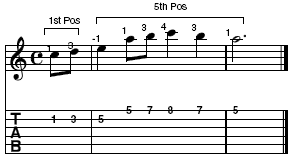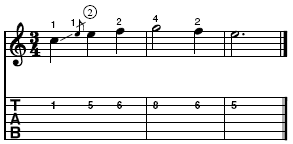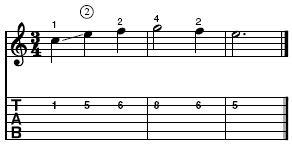Ways to Change Position
Straightforward chord playing often involves jumping from position to position,
but more complex solos are usually fingered to take advantage of smoother ways to
make the transitions. The simplest is when the move is covered by an open string,
like this:

Using an open string
The open string rings over while the hand moves up.
The Guide Finger
Often the left hand finger can act as a guide up the string. This is one of the
most common ways and it’s important to understand.

Here’s the sequence. The first finger is used for the C, and stays on the string
when the D is played. Then it travels up the string to the fifth fret without losing
contact with the string. It doesn’t have to press hard—just enough to keep contact
and use the string as a guide rail. This movement is often shown with a small minus
sign beside the destination finger (see the example above).
The Portamento
The portamento is a nice technique. It can make a position change easier, but
it can also add a sound to the movement which, like a slur, adds smoothness to the
musical passage. Here’s an example:

The first note is played and held for almost its full time value. Then, with
the note still sounding, the finger travels up the string to the fifth fret in time
to play the E on the second beat. The small note indicates simply that the E is
played normally to distinguish it from the slide (see below). The finger maintains
a light pressure on the string, and there is a slight “scoop” sound as it moves
up. This linking sound should not be too pronounced—the real secret is to leave
the first finger in place until the last possible moment, and then to travel quickly
up.
This is the kind of technique that requires experimentation until a satisfactory
sound is achieved.
The Slide (Arrastre)
The slide, also known as the arrastre, is very similar to the portamento, except
that the second note is not played by the right hand. The example below shows what
happens.
- The C is played.
- The note is held for almost its full value. Just before the next beat, the
finger slides up the string to arrive at the E exactly on the beat. The D will
be heard, but obviously with diminished volume. Like the portamento, it has
the effect of adding smoothness or legato to a passage.

|